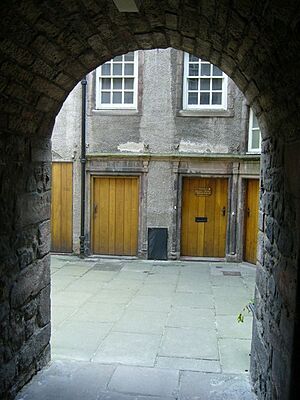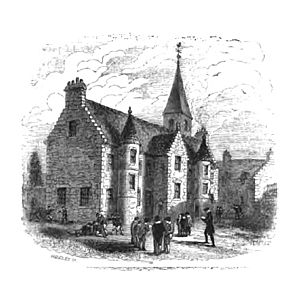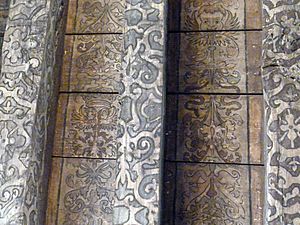John MacMorran facts for kids
John MacMorran (1553-1595) was a rich merchant in Edinburgh, Scotland. He was also a "Baillie," which was like a town council member or a local judge. MacMorran was sadly killed during a student protest at the Edinburgh High School. His beautiful house, called Riddle's Court, is still standing today. It is a famous building on Edinburgh's Lawnmarket.
Contents
A Wealthy Merchant's Life
John MacMorran was very successful in business, especially in shipping. He owned parts of nine ships, which were worth a lot of money when he died. He also exported valuable goods like wax and salmon. This made him one of the richest merchants in Edinburgh during his time.
He built a large house on Edinburgh's Lawnmarket. This house is now known as Riddle's Court. A special carved window frame from his house was even shown at the Huntly House museum.
MacMorran worked for Regent Morton, a powerful leader, in the 1570s. People sometimes complained that MacMorran sold grain to Spain, a Catholic country, even when there wasn't much food in Scotland.
In 1590, MacMorran was in Dover, England. He was trying to get back money for two cannons and some lead. These items had been stolen from one of his ships four years earlier. He wrote to a Scottish diplomat to help him solve this problem.
Tragedy at Edinburgh High School
In 1595, students at Edinburgh High School were upset about how long their holidays were. They decided to protest by locking themselves inside the school building. The school was then located near what is now Drummond Street.
After two days, on September 15, 1595, the town council sent John MacMorran to end the protest. As a Baillie, it was his job to keep order. MacMorran and his men tried to break into the school using a large wooden beam. Suddenly, a shot was fired from a window. It hit MacMorran in the forehead, and he died right away. The shot was fired by a 13-year-old boy. He was the son of William Sinclair, who was related to the Earl of Caithness.
The boys either ran away or were caught. Getting justice for MacMorran's death took a long time. Both the students' families and MacMorran's family were wealthy. They were able to ask James VI of Scotland, the King, to get involved.
Eventually, the 13-year-old William Sinclair and all the other students were set free without any punishment. The schoolmaster, Hercules Rollock, who was also a poet, was fired because of the incident.
John MacMorran was buried in the Greyfriars kirkyard. A special message in Latin was carved on his memorial. It praised his service to the town.
MacMorran's Famous Home: Riddle's Court
After John MacMorran died, his house and business went to his brother, Ninian. Ninian managed everything for John's children and his wife, Katherine Hutcheson.
John MacMorran owned parts of several ships, including the Anna, the Grace of God, and the Good Fortune. He also had a lot of gold coins. A list of all the furniture and items in his house at the time of his death still exists today.
Later, Alexander Seton, 1st Earl of Dunfermline, a important Scottish leader, rented rooms from MacMorran. This was probably at Riddle's Court. In 1597, King James VI met with the English ambassador in Seton's garden there.
Royal Parties at Riddle's Court
In 1598, two big parties were held at Riddle's Court. They were for Ulrik, Duke of Holstein. He was the younger brother of Anne of Denmark, who was King James VI's wife and Queen of Scotland.
One party on May 2, 1598, was very grand and fun. King James VI and Queen Anne of Denmark were there. The Queen's Danish cook, Hans Poppilman, was paid for his work. A Flemish candy maker, Jacques de Bousie, made fancy sugar treats. He was paid a lot of money for his sweet creations. Special spiced wine called Hippocras was also served.
Beautiful tapestries were borrowed from Holyrood Palace to decorate the house. Two French experts helped arrange the table settings. Ninian MacMorran was paid back for some of his best napkins that were lost during the party. More parties for the Duke of Holstein were held later that month. Some of the painted decorations still seen in the house today might be from these special royal visits.
Riddle's Court Today
In the mid-1700s, the famous Scottish philosopher David Hume lived at Riddle's Court. He started writing his book "The History of England" there.
In 1890, a man named Patrick Geddes helped restore the building. He wanted to use it as a place for university students to live. Today, the Scottish Historic Buildings Trust (SHBT) takes care of Riddle's Court. It is now home to the Patrick Geddes Centre for Learning. This center is an educational part of the SHBT.




